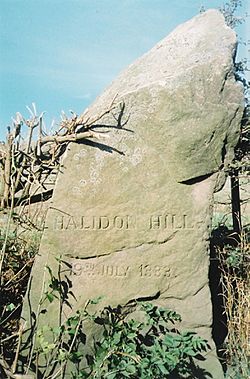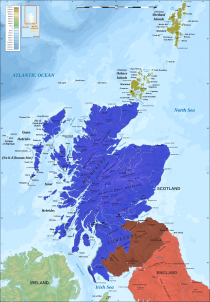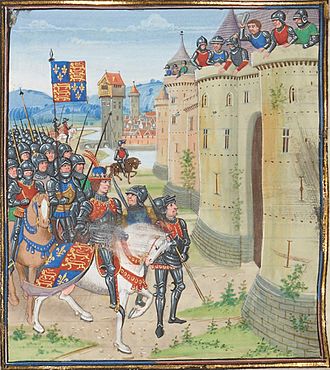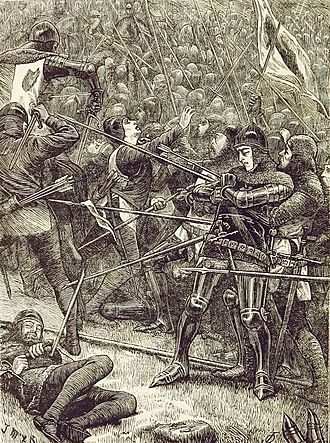Battle of Halidon Hill facts for kids
Quick facts for kids Battle of Halidon Hill |
|||||||
|---|---|---|---|---|---|---|---|
| Part of the Second War of Scottish Independence | |||||||
 Monument marking the site of the battle |
|||||||
|
|||||||
| Belligerents | |||||||
| Commanders and leaders | |||||||
| Sir Archibald Douglas † |
|||||||
| Strength | |||||||
| Up to 20,000 | Less than 10,000 | ||||||
| Casualties and losses | |||||||
| Unknown. | Very few | ||||||
The Battle of Halidon Hill took place on 19 July 1333. It was a major fight during the Second War of Scottish Independence. Scottish forces, led by Sir Archibald Douglas, faced a strong defeat. They were fighting against the English army of King Edward III of England. The battle happened on difficult ground as the Scots tried to help the town of Berwick-upon-Tweed.
Contents
Why the Battle Happened
The first war between England and Scotland began in 1296. King Edward I of England attacked the Scottish town of Berwick. After 30 years of fighting, a peace treaty was signed in 1328. This was the Treaty of Northampton. Many people in England disliked it and called it "the cowards' peace."
Some Scottish nobles had lost their lands because they did not support King Robert Bruce. They were called the "Disinherited." These nobles joined Edward Balliol, whose father, John I, had been a king of Scotland.
When Robert Bruce died in 1329, his son David II was only five years old. Edward Balliol and the Disinherited nobles planned to invade Scotland. King Edward III of England pretended not to support them. But secretly, he was happy for them to cause trouble for Scotland.
In 1332, Edward Balliol invaded Scotland. His small army defeated a much larger Scottish force at the Battle of Dupplin Moor. Balliol was crowned king of Scotland. He then gave King Edward III some Scottish lands, including Berwick. But Balliol's rule did not last long. He was attacked and had to flee to England. He asked Edward III for help.
Edward III then openly supported Balliol. He prepared for war. His main target was Berwick. This town was very important for trade and was a key gateway between Scotland and England. Edward III hoped that attacking Berwick would force the Scots to fight a big battle. The Scots usually avoided large battles, preferring smaller attacks. But losing Berwick was something they could not allow.
Getting Ready for Battle
Archibald Douglas was the Guardian of Scotland. This meant he ruled for the young King David II. Douglas prepared Berwick for a long siege. The town had strong walls, up to 40 feet thick and 22 feet high. They were protected by towers. Berwick Castle was also very strong. The town had plenty of food and supplies.
The Siege of Berwick
Edward Balliol and his Scottish and English allies crossed into Scotland in March 1333. They burned and looted towns. They reached Berwick in late March and surrounded it by land. The English navy also blocked the town by sea. King Edward III arrived with his main army on May 9.
The English dug trenches and cut off Berwick's water supply. They also burned the land around the town. This stopped anyone from bringing supplies to Berwick. The English army used large trebuchets, which were like giant slingshots, to throw stones at the town.
Archibald Douglas had gathered a large Scottish army. But he did not attack the English right away. He waited, gathering more troops. He sent small groups to raid English areas, but these raids were not enough to make Edward III leave Berwick.
By late June, Berwick was badly damaged. The defenders were tired. The town's governor, Sir Alexander Seton, asked for a truce. Edward III agreed, but only if Seton promised to surrender by July 11 if no help arrived. Seton's son, Thomas, and eleven others were taken as hostages.
The Scottish Relief Force
Douglas now had to act. He had to save Berwick, just as the English had tried to save Stirling Castle in 1314. The Scottish army was much larger than the English, possibly twice as big.
On July 11, the last day of the truce, Douglas led his army into England. He destroyed the town of Tweedmouth, which was near Berwick. Edward III did not move his army.
A small group of Scottish cavalry, led by Sir William Keith, managed to get into Berwick. Douglas thought this meant the town had been "relieved." He sent a message to Edward III, telling him to leave. But Edward III disagreed. He said the truce meant the town had to be relieved directly from Scotland. Since Keith's men came from the direction of England, Edward III said the truce was broken.
To show he was serious, Edward III built a gallows outside the town walls. He hanged Thomas Seton, the governor's son, while his parents watched. Edward said he would hang two more hostages each day if the town did not surrender.
Sir William Keith, now in charge of Berwick, made a new truce on July 15. He promised to surrender if no help arrived by sunset on July 19. The new agreement clearly stated how Berwick could be saved. Either 200 Scottish soldiers had to fight their way in, or the Scottish army had to cross a specific part of the River Tweed, or the English army had to be defeated in a big battle.
Douglas marched his army south to Bamburgh, where Edward III's queen was staying. He hoped this would make Edward III leave Berwick. But Edward III ignored the threat. He placed his army on Halidon Hill, a small hill about 600 feet high, two miles northwest of Berwick. From here, he could see the town and control the river crossing. Douglas realized he had no choice but to fight.
The Battle of Halidon Hill
On July 19, the Scottish army approached Halidon Hill. To attack the English, the Scots had to go downhill, cross a marshy area, and then climb the hill. They knew how dangerous English arrows could be from a previous battle. It would have been safer to wait, but that would mean losing Berwick.
The battle started around midday. Douglas ordered an attack. English archers fired thousands of arrows. The Lanercost Chronicle said the Scots were "so wounded in the face and blinded by the multitude of English arrows that they could not help themselves." Many Scots fell dead or wounded at the bottom of the hill.
The remaining Scots kept going, through arrows "as thick as motes in a sun beam." But when they reached the top, they met the English soldiers with their long spears. The Scottish army broke apart. Many ran away.
Thousands of Scots died in the battle, including Douglas and five Scottish earls. The English lost very few soldiers, some reports say as few as seven. About a hundred Scottish prisoners were killed the next morning.
On July 20, the day the truce ended, Berwick and its castle surrendered to the English.
What Happened After

After the victory, King Edward III went south. Edward Balliol stayed in Scotland to deal with any remaining resistance. In 1334, Balliol officially became Edward's loyal subject for Scotland. He also gave England eight counties in southeast Scotland.
Balliol tried to rule Scotland from Perth. He gave back lands to the "Disinherited" nobles. But this meant many other Scottish nobles lost their lands, which caused more fighting. Balliol was removed from power in 1334, brought back in 1335, and finally removed for good in 1336.
Berwick remained under English control for a long time. It was an important military base on the border until 1461. It was briefly returned to Scotland but was taken back by the English in 1482. Berwick remained a disputed town for many years.
The battle was a huge defeat for Scotland. Thousands of Scottish soldiers died, including many important nobles. English losses were very small.
Images for kids
See also
 In Spanish: Batalla de Halidon Hill para niños
In Spanish: Batalla de Halidon Hill para niños




